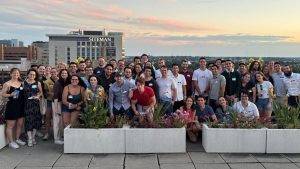Misinformation in the media can lead to conflict and fear
Published December 10, 2015
Since mid-September, Israel has been experiencing a wave of terror. Ever since the current string of violence erupted, rampant misinformation has become the norm as mainstream media outlets have fallen short in their news reports about Israel. By speaking with two Israel-advocacy nonprofits, StandWithUs and American Jewish Committee (AJC), and utilizing media transparency sites such as CAMERA, certain patterns begin to emerge from thousands of news stories.
Unbiased reporting in all arenas, Israel especially, is extremely important. In a region of rampant terror, attacks can be inspired by a single story.
“People can die or be hurt from poor reporting,” freelance journalist Hody Nemes said.
ADVERTISEMENT
The situation can only go downhill once a false report is released. Faulty or stilted facts can cause distorted beliefs and ultimately provide cause for tension and conflict.
“It is very hard to retract untrue stories,” said StandWithUs CEO Roz Rothstein. “People believe what they read and hear. At best, it’s misinformation, at worst it is cause for violence.”
While factually inaccurate articles are sometimes easy to identify, “spun” stories effectively blur the line between fact and fiction, making them much more difficult to classify. Articles of this sort usually involve an overwhelming amount of bias in an attempt to bend facts into lies. These types of stories have been gradually rising as the media evolves.
“I think the mainstream media in general has changed,” said AJC St. Louis director Nancy Lisker. “With the advent of 24/7 cable news, now with social media and individuals writing blogs, some sources are not very viable. Many are reporting truthfully, many are not. It’s harder and harder to keep track of the truth.”
ADVERTISEMENT
Stories can be spun in a variety of ways. Lisker pointed out some of the main tactics to subtly change the message of a story.
“Some publications’ coverage is more balanced than others in giving equal weight to each side of the argument. Others, simply choose to print blatant distortions of the facts. The media [may also] tend to oversimplify by underreporting, changing reality, overlooking details, or blatantly changing them…[and] the last way is to use different photos or videos from other conflicts or countries,” Lisker said.
The most obvious of the three is inaccurate headlines. In recent months, several inaccurate headlines were printed by major news outlets. Among them, one from the New York Times that read: “1 Israeli and 3 Palestinians Killed in Attacks in West Bank.” These headlines imply the three Palestinians were victims, when they were actually armed assailants.
“As a reporter, I’ve learned that headlines and photos are [often] more important than the article’s content,” Nemes said.
It is sometimes tough to tell if the information in an article is truthful or spun. Perhaps the best way to uncover the truth is to search out multiple stories that include several sources and viewpoints. Rothstein had some advice on receiving accurate Israeli news.
“Read many different sources and piece the truth together from different perspectives and draw your own conclusions. Some of the best [sources to refer to] include Ynet, The Jerusalem Post, and the Times of Israel,” Rothstein said.
One other way to steer clear of inaccuracies is to be skeptical of news produced on social media. While helpful in some fields, such as providing first-hand accounts and videos not seen in print journalism, there is reason to distrust these sources.
“For some people, that’s their only source of news. That’s all right for buying jeans, but not for judging European anti-Semitism,” Lisker said.
The Palestinian government uses its control of the media to its advantage. A 2014 study by the Times of Israel found that more than 80 percent of Palestinian reporters practice self-censorship, many citing fear of the government as a contributing factor. Social media is a way around these restrictions.
“Unfortunately, we saw last year in Operation Protective Edge that the traditional media was pressured by terrorist organizations like Hamas not to report certain facts on the ground in Gaza,” said Emily Schrader, StandWithUs’ social media director. “Social media provides a platform to take poor journalism to task when they make mistakes…This is an opportunity, a conversation, that just isn’t possible in the mainstream media and it gives voice to the people.”
Media can dictate the way people think about important issues. It is dangerous to allow journalists with biased narratives to make decisions about complex issues for readers. In following current events, it is important to remember that the author of any piece is a person with opinions of his or her own.
Society, however, cannot turn its back on all Israel-related news simply based on these inaccuracies. As Jews, frustration with the media is no excuse to step out of the Israel debate.
“We are the ‘People of the Book’ and have to question things,” Lisker said. “We don’t always have to be on the side of Israel, but we need to be educated so that we can defend it. If Jews don’t defend it, no one will.”















